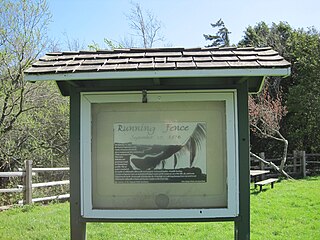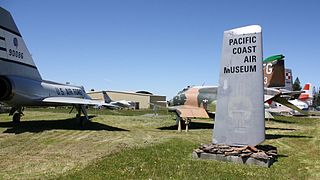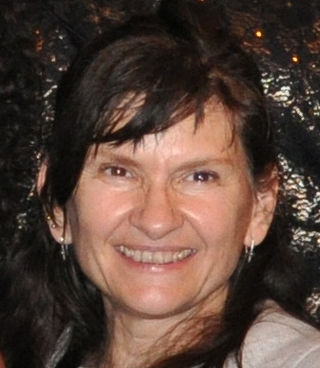
Sonoma County is located in the U.S. state of California. As of the 2020 United States Census, its population was 488,863. Its seat of government and largest city is Santa Rosa. It is to the north of Marin County and the south of Mendocino County. It is west of Napa and Lake Counties.

Santa Rosa is a city in and the county seat of Sonoma County, in the North Bay region of the Bay Area in California. Its population as of the 2020 census was 178,127. It is the largest city in California's Wine Country and Redwood Coast. It is the fifth most populous city in the Bay Area after San Jose, San Francisco, Oakland, and Fremont; and the 25th-most populous city in California.
The Peel Art Gallery, Museum and Archives (PAMA) is a museum, art gallery, and archives for the Regional Municipality of Peel and are located in Brampton, Ontario, Canada. Previously, it was the Peel Heritage Complex. Its facilities were originally the Peel County Courthouse, Brampton Jail, a land registry office, and a county administration building. It is opposite Gage Park and Brampton City Hall.

The Denver Art Museum (DAM) is an art museum located in the Civic Center of Denver, Colorado. With encyclopedic collections of more than 70,000 diverse works from across the centuries and world, the DAM is one of the largest art museums between the West Coast and Chicago. It is known for its collection of American Indian art, as well as The Petrie Institute of Western American Art, which oversees the museum's Western art collection. and its other collections of more than 70,000 diverse works from across the centuries and world. The museum's Martin Building was designed by famed Italian architect Gio Ponti in 1971.

The San José Museum of Art (SJMA) is a modern and contemporary art museum in downtown San Jose, California, United States. Founded in 1969, the museum holds a permanent collection with an emphasis on West Coast artists of the 20th and 21st centuries. It is located at Circle of Palms Plaza, beside Plaza de César Chávez. A member of North American Reciprocal Museums, SJMA has received several awards from the American Alliance of Museums.

Christo Vladimirov Javacheff (1935–2020) and Jeanne-Claude Denat de Guillebon (1935–2009), known as Christo and Jeanne-Claude, were artists noted for their large-scale, site-specific environmental installations, often large landmarks and landscape elements wrapped in fabric, including the Wrapped Reichstag, The Pont Neuf Wrapped, Running Fence in California, and The Gates in New York City's Central Park.

The Portland Art Museum (PAM) is an art museum in downtown Portland, Oregon, United States. The Portland Art Museum has 240,000 square feet, with more than 112,000 square feet of gallery space. The museum’s permanent collection has over 42,000 works of art. PAM features a center for Native American art, a center for Northwest art, a center for modern and contemporary art, permanent exhibitions of Asian art, and an outdoor public sculpture garden. The Northwest Film Center is also a component of Portland Art Museum.
Santa Rosa Junior College (SRJC) is a public community college in Santa Rosa, California with an additional campus in Petaluma and centers in surrounding Sonoma County. Santa Rosa Junior College was modeled as a feeder school for the University of California system. SRJC is operated by the Sonoma County Community College District.
Events from the year 1976 in art.

Joseph Jacinto Mora was a Uruguayan-born American cowboy, photographer, artist, cartoonist, illustrator, painter, muralist, sculptor, and historian who lived with the Hopi and wrote about his experiences in California. He has been called the "Renaissance Man of the West".

The Santa Barbara Museum of Art (SBMA) is an art museum located in downtown Santa Barbara, California.
Mario Joseph Ciampi was an American architect and urban planner best known for his modern design influence on public spaces and buildings in the San Francisco Bay Area.

John Carl Warnecke was an architect based in San Francisco, California, who designed numerous notable monuments and structures in the Modernist, Bauhaus, and other similar styles. He was an early proponent of contextual architecture. Among his more notable buildings and projects are the Hawaii State Capitol building, the John F. Kennedy Eternal Flame memorial gravesite at Arlington National Cemetery, and the master plan for Lafayette Square.

The Pérez Art Museum Miami (PAMM)—officially known as the Jorge M. Pérez Art Museum of Miami-Dade County—is a contemporary art museum that relocated in 2013 to the Museum Park in Downtown Miami, Florida. Founded in 1984 as the Center for the Fine Arts, it became known as the Miami Art Museum from 1996 until it was renamed in 2013 upon the opening of its new building designed by Herzog & de Meuron at 1103 Biscayne Boulevard. PAMM, along with the $275 million Phillip and Patricia Frost Museum of Science and a city park which are being built in the area with completion in 2017, is part of the 20-acre Museum Park.

Running Fence was an installation art piece by Christo and Jeanne-Claude, which was completed on September 10, 1976. The art installation was first conceived in 1972, but the actual project took more than four years to plan and build. After it was installed, the builders removed it 14 days later, leaving no visible trace behind.
The Rensselaer County Historical Society (RCHS) is a non-profit, historical society and museum, to promote the study of the history of the Rensselaer County, NY. RCHS was founded in 1927, and originally operated out of a single room in the Troy Public Library, collecting manuscripts and published materials related to the county's history. It is located in the Central Troy Historic District, in Troy, NY. The Rensselaer County Historical Society operates a museum, and offers public programs from its location at 57 Second Street, Troy, NY.

The Pacific Coast Air Museum, in Santa Rosa, California, is a non-profit organization dedicated to promoting and preserving aviation history through the acquisition, restoration, and display of historic aircraft. The museum displays a varied collection of over 30 American military, propeller, and jet aircraft.
Marion Gray was an American artist, photographer, and teacher. A vital member of the Bay Area art scene since the 1970s, Gray's "work blurs the lines between documentation and art, and exposes shared approaches between artists working in dance, performance and visual arts." During her long career, Gray documented the performances and works of artists such as John Cage, Christo and Jeanne Claude, Merce Cunningham, Joan Jonas, Marina Abramovic, Meredith Monk, Paul Dresher, Guerrilla Girls, and many others. As curator Christina Linden explains: "her photographs, themselves powerful works of art, constitute an immensely valuable archive of the ephemeral artistic activity the Bay Area has historically fostered.”

Kim Victoria Abeles is an American interdisciplinary artist and professor emeritus. She was born in Richmond Heights, Missouri, and currently lives in Los Angeles. She is described as an activist artist because of her work's social and political nature. In her work, she’s able to express these issues and shine a light on them to larger audiences. She’s able to show the significance of the issues by creating a piece that involves an object and adds the struggle attached to it, which represents what is happening in current events. She is also known for her feminist works. Abeles has exhibited her works in 22 countries and has received a number of significant awards including a Guggenheim Fellowship. Aside from her work as an artist, she was a professor in public art, sculpture, and drawing at California State University, Northridge from 1998 to 2009, after which she became professor emerita in 2010.
Surrounded Islands, Biscayne Bay, Greater Miami, Florida, 1980–83 was a 1983 environmental artwork in which artists Christo and Jeanne-Claude surrounded an island archipelago in Miami with pink fabric.
















